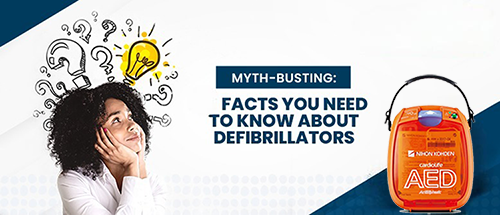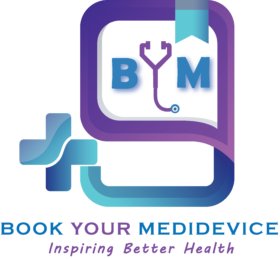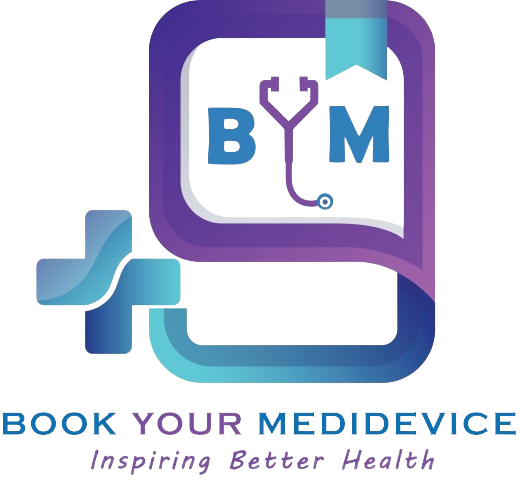Common Myths About Defibrillators Debunked
August 21, 2024 2024-08-21 12:31Common Myths About Defibrillators Debunked

Common Myths About Defibrillators Debunked
Discover the truth behind common myths about defibrillators in this informative blog. Learn why defibrillators, including AEDs, are easy to use even for non-medical professionals, how they safely determine when a shock is necessary, and why they don’t restart a stopped heart but correct life-threatening arrhythmias. Uncover the facts about using defibrillators in wet environments, their affordability for public and personal use, and the legal protections offered by Good Samaritan laws. Don’t let misconceptions prevent you from taking action in a cardiac emergency—be informed and ready to save a life with confidence.
Myth 1: Only Medical Professionals Can Use a Defibrillator
Reality: One of the most pervasive myths about defibrillators is that they are complicated devices that only trained medical professionals can use. This belief is not only false but also dangerous. AEDs are designed specifically to be user-friendly, so even someone with no medical training can operate them effectively.
Modern AEDs come with clear, step-by-step voice and visual instructions. They guide the user through the entire process, from attaching the pads to delivering the shock if necessary. The device itself analyzes the heart’s rhythm and determines if a shock is needed. It will only deliver a shock if it detects a life-threatening arrhythmia, such as ventricular fibrillation or ventricular tachycardia. This automated feature ensures that the device is safe and easy to use for anyone, even in high-pressure situations.
Myth 2: You Can Accidentally Shock Someone Who Doesn’t Need It
Reality: AEDs are equipped with sophisticated algorithms that assess the heart’s rhythm and decide whether a shock is necessary. This process eliminates the possibility of delivering a shock to someone who doesn’t need it. AEDs will not administer a shock if the heart is not in a shockable rhythm, such as a normal heartbeat or asystole (a flatline).
The fear of accidentally harming someone with an AED is unfounded. The device’s safety features are designed to prevent unnecessary shocks. In fact, attempting to use an AED on someone in cardiac arrest, even if you’re unsure, is far better than doing nothing. The sooner defibrillation is provided, the better the chances of survival.
Myth 3: Defibrillators Can Restart a Stopped Heart
Reality: This is a common misconception, likely due to how defibrillators are portrayed in movies and television shows. The reality is that defibrillators do not restart a heart that has completely stopped (asystole). Instead, they work by delivering an electric shock to correct certain types of abnormal heart rhythms, such as ventricular fibrillation or ventricular tachycardia, that can lead to cardiac arrest.
When the heart is in ventricular fibrillation, it quivers ineffectively instead of pumping blood. A defibrillator shock can stop the chaotic electrical activity, allowing the heart’s natural pacemaker to regain control and restore a normal rhythm. If the heart has completely stopped, other interventions like CPR (cardiopulmonary resuscitation) are necessary to maintain circulation until more advanced medical treatment can be provided.
Myth 4: Using a Defibrillator is Too Risky in Wet Environments
Reality: Another common myth is that defibrillators should not be used if the patient or the environment is wet. While it’s true that water conducts electricity, AEDs are designed to be safe even in less-than-ideal conditions. If the patient is wet, you should make an effort to dry their chest before applying the AED pads. This helps the device accurately detect the heart’s rhythm and ensures that the shock is delivered effectively.
However, the presence of moisture doesn’t mean you can’t use an AED at all. The key is to minimize the risk by drying the chest area as much as possible. Additionally, most modern AEDs are designed to function in a variety of environments, including areas where there may be some moisture, such as around swimming pools or in the rain. The potential benefits of using an AED far outweigh the risks of not using it in these situations.
Myth 5: Defibrillators Are Expensive and Only for Hospitals
Reality: While defibrillators were once primarily found in hospitals, advances in technology have made AEDs more affordable and accessible to the public. AEDs are now commonly found in schools, airports, shopping malls, gyms, and even homes. Many businesses and community organizations recognize the importance of having an AED on hand and have invested in these devices.
The cost of an AED can vary, but the price has decreased over the years, making them more accessible for individuals and organizations. Moreover, many communities offer grants or funding assistance to place AEDs in public spaces. The investment in an AED can mean the difference between life and death in the event of a cardiac emergency, making it a worthwhile purchase for many.
Myth 6: If You Use an AED Incorrectly, You Can Be Sued
Reality: Fear of legal repercussions is another barrier that prevents people from using AEDs during emergencies. However, Good Samaritan laws exist in many regions to protect individuals who attempt to help in emergency situations. These laws generally provide legal protection to bystanders who assist someone in distress, including the use of an AED, as long as they act in good faith.
The intent of these laws is to encourage people to assist during emergencies without fear of legal consequences. It’s important to note that these laws vary by location, so it’s a good idea to be familiar with the specific regulations in your area. Nevertheless, the overall risk of legal action is low, and the focus should be on the life-saving potential of using an AED.
Conclusion
Defibrillators, especially AEDs, are essential tools in the fight against sudden cardiac arrest. By dispelling these common myths, we hope to encourage more people to feel confident in using these life-saving devices when needed. Remember, the quick use of a defibrillator can significantly increase the chances of survival in a cardiac emergency. Don’t let misconceptions prevent you from taking action—being informed and prepared can make all the difference.
4o



